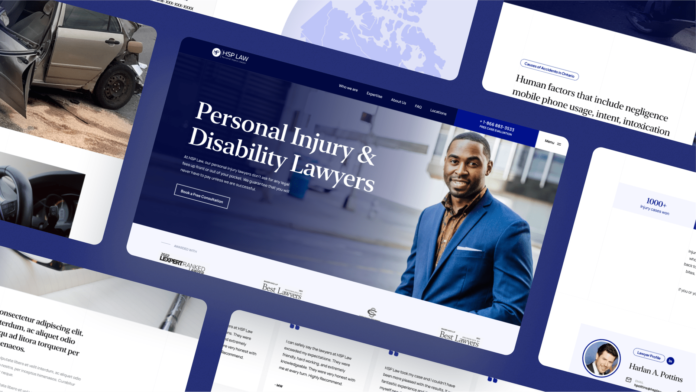
The legal sector isn’t exempt from the need to establish a strong online presence. A law firm’s website acts as its digital doorstep. However, creating an impactful website doesn’t always mean depleting financial resources. This article unveils strategies to design a compelling online presence for your legal business without breaking the bank.
Key Elements of an Effective Law Firm Website
Understanding the core components of a successful legal website is crucial. The first principle is clarity. Potential clients should grasp what you offer within seconds. Seamlessly integrating lawyer website design into this clarity ensures that visitors quickly associate your site with legal expertise. On the other hand, credibility plays a pivotal role. First impressions matter, and showcasing your firm’s achievements and qualifications is paramount.
Setting Clear Objectives for Your Website Design
Before diving into the design process, it’s vital to establish what you want to achieve. Are you looking to inform potential clients about your services? Or maybe you want to showcase past successes to establish authority in your field? Knowing your purpose ensures your design aligns with your firm’s goals.
On a similar note, these objectives should serve as a roadmap. They will guide decisions on layout, content, and functionalities, ensuring your site meets both your needs and those of your visitors.
Identifying Budget-Friendly Website Design Strategies
There’s a misconception that effective web design requires vast financial investments. In truth, many tools and platforms offer affordable options that don’t skimp on quality. For instance, using pre-made templates can reduce costs without sacrificing professionalism.
Meanwhile, open-source solutions offer a world of customization possibilities, often free of charge. The key is to research and find solutions tailored to your needs.

Choosing the Right Platform and Hosting Services
Selecting an appropriate platform lays the foundation for your site. WordPress, for example, is both user-friendly and versatile, making it a favorite among many professionals.
This platform’s extensibility means it can grow with your firm. As for hosting, it’s essential to prioritize reliability. A site that’s frequently down can repel potential clients. Look for hosting services known for their uptime, solid customer support, and security features.
Essential Design Principles for Professional Appeal
The aesthetics of your site can either make or break a visitor’s trust. Lean towards clean, modern designs that emphasize professionalism. Avoid clutter; instead, use whitespace effectively to draw attention to essential information.
Trust indicators, such as badges from legal associations or security certificates, can further enhance your site’s credibility. Beyond aesthetics, the user experience is paramount. A responsive design that looks and functions well on all devices is no longer a luxury—it’s a necessity.
Content Creation and Organization for Law Firm Websites
Content is king, even in the legal realm. Crafting clear, concise, and relevant content positions your firm as an authority. Focus on addressing potential clients’ needs, answering their questions, and showcasing your expertise. Structuring this content is equally essential.
Use logical categories and subcategories, making it easy for visitors to find the information they seek. Consider using tools like infographics to break down complex topics into digestible pieces.

Integrating User-Friendly Navigation and Accessibility
Ease of navigation can drastically affect user experience. Prioritize intuitive menu designs and ensure that critical pages are easily accessible. This not only keeps visitors on your site longer but also aids in converting them into clients.
Parallelly, ensuring your site is accessible to all users, including those with disabilities, is both a moral and legal obligation. Implement features like screen reader compatibility and adjustable font sizes to make your site inclusive.
Leveraging SEO Techniques for Improved Visibility
A beautifully designed website is pointless if no one sees it. Search Engine Optimization (SEO) ensures your site ranks high on search engines. Begin with keyword research, identifying terms potential clients might use. Integrate these keywords naturally into your content. Backlinks, or links from other reputable sites to yours, can further boost your search ranking. However, it’s essential to ensure these links are genuine and from credible sources.
Utilizing Engaging Visuals and Multimedia Elements
A picture is worth a thousand words. Incorporate high-quality images that resonate with your firm’s ethos and the services you provide. Infographics can simplify complex legal concepts, making them more palatable for the general public. Videos, whether they’re testimonials, explainer videos, or introductions, can engage visitors and keep them on your site longer. However, ensure all multimedia elements are optimized for fast loading times to avoid frustrating your visitors.
Implementing Client Testimonials and Case Studies
Word of mouth, even in digital form, carries weight. Displaying genuine testimonials offers social proof, showing potential clients that others trust your services. Equally valuable are case studies. These in-depth looks into specific cases you’ve handled not only showcase your expertise but also humanize your firm, allowing visitors to see the real people behind the legal jargon.
Mobile Responsiveness ─ Ensuring Cross-Device Compatibility
More than half of all web traffic now comes from mobile devices. Hence, ensuring your site functions flawlessly on smartphones and tablets is critical. A mobile-optimized site ensures that text is readable, buttons are clickable, and pages load quickly, regardless of the device used. Not only does this offer a better user experience, but search engines also favor mobile-optimized sites in rankings.
Incorporating Contact Forms and Effective Calls-to-Action
The ultimate goal of your site is likely to convert visitors into clients. Clear calls-to-action, guiding visitors towards consultations or contact forms, is essential. Keep these forms simple, asking only for necessary information. A live chat feature can also be invaluable, offering real-time assistance and further building trust with potential clients.

Final Thoughts
While the digital landscape might seem daunting, especially with the myriad of factors to consider, creating a robust online presence for your law firm doesn’t have to be costly. By understanding your objectives, utilizing budget-friendly tools, and focusing on both aesthetics and user experience, you can set your firm apart in the digital realm. Remember, your website is more than just a digital business card—it’s a reflection of your commitment to excellence.









